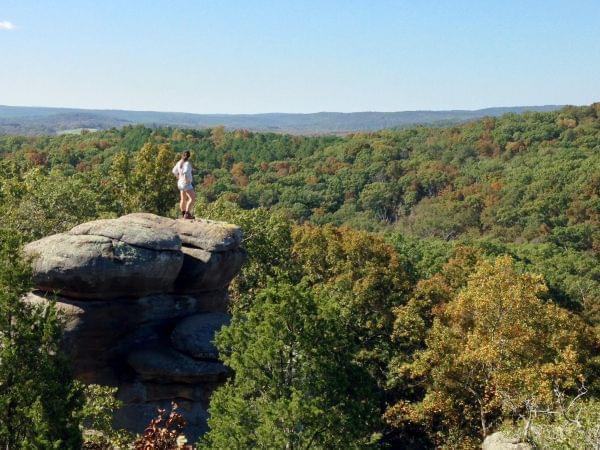Are we really in Illinois?

A student atop a hoodoo. Rob Kanter
One of the most enjoyable aspects of my work at the U of I is teaching a one-credit-hour field course that runs during the first half of the fall semester. The course provides students who are new to the Earth, Society, and Environmental Sustainability major an introduction to the types of work done by faculty in the Departments of Geology, Atmospheric Sciences and Geography and Geographic Information Science. It culminates in a trip to far southern Illinois, which is where I was last weekend.
We arrive at the University’s Dixon Springs Agricultural Center too late on Friday evening to do anything but go to bed (at least for the trip leaders), but we start early on Saturday.
Our destination for the morning is the Garden of the Gods Recreation Area in the Shawnee National Forest. There, a quarter-mile long trail gives visitors access to sandstone cliffs and rock formations that can prompt first-timers to question whether or not they’re still in the Prairie State. We make stops to talk about how sandstone forms and how geologists sort through evidence to explain the genesis of some unusual landscape features, including isolated stone towers, “hoodoos,” and raised circular rings in stone faces, “Liesegang banding.”
We also make time to observe the sky, especially since we’re accompanied by my colleague Jeff Frame from the Department of Atmospheric Sciences. He’s a storm chaser through and through, so blue skies like we had this past weekend are something of a disappointment to him. In addition, we take time to just “be,” and climb around a bit where the rock formations allow that.
We picnic for lunch as a way of keeping costs low and making the most of our time in the field. After eating, we rest on a grassy slope to hear a talk about the roles played by the Civilian Conservation Corps in the construction of area park facilities and the lives of the men who took part in the program. The talk is given by historian Kay Rippelmeyer, a long-time southern Illinois resident whose research has involved extensive firsthand interviews with men who served in “the C’s,” and whose enthusiasm and expertise prompted one student to comment, “I could listen to her all day.”
On Saturday afternoon, we hike to see a cypress swamp at Heron Pond, a nature preserve in the Cache River State Natural Area. Seeing the towering baldcypress trees, with their wide, buttressed foundations and “knees” that rise up from their roots again prompts some first-timers to wonder whether they’re still in Illinois.
The path to and from the swamp winds through the floodplain of the Cache River, which offers those inclined (including myself) opportunities to look for wildlife, especially reptiles and amphibians. Tiny cricket frogs are hyper-abundant there, and their frenzied hopping can make the riverbank look alive as you walk among them. As you avoid stepping on frogs it’s also important to keep an eye out for snakes; this year we came across three water moccasins by the river. That’s a treat for some of us, but they’re venomous, so this is definitely a “look but don’t touch” encounter.
Dinner is pasta we cook for ourselves at the Ag Center, and then we’re back outside for a campfire and stargazing. Thanks to cloudless skies and a nearly new moon on Saturday, we were able to see the spread of the Milky Way galaxy across the sky—also a first for many students.
Before heading back to Champaign on Sunday afternoon, we pack in a visit to Tanglefoot Ranch, where farmer Grover Webb and others produce food like no place else in the state—or the world, for that matter. But that’ll have to be a story for another day.
Tune in next week for student perspectives on the trip.
